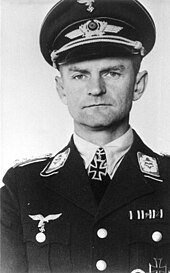Günter Schwartzkopff
Günter Schwartzkopff (* 5. August 1898 in Forbach (administrative district Posen ); † 14. May 1940 south of Le Chesne ( France )), a German was an officer of the Air Force of the Armed Forces . He was posthumously promoted to major general and was considered a pioneer of the Ju 87 fall combat technique .
Military biography
First World War
After the outbreak of World War I , Schwartzkopff served as a flag junior and platoon leader in Infantry Regiment No. 47 on the Western Front . In the summer of 1916 he was wounded near Verdun and after his recovery he joined the air force . There Schwartzkopff received his training as a pilot from August 30, 1916 to January 1917 at Flieger-Ersatz -teilung 8 . He then flew until March 1917 as a pilot in Aviation Department 4 and then until November 1917 with the renamed Feldfliegerabteilung 4 , where he was also employed as a technical officer. Schwartzkopff flew the last year of the war in Fliegerabteilung 13 on the Eastern Front .
Interwar years
In December 1918 Schwartzkopff came to the Grenzschutz-Fliegerabteilung 106 as a technical officer , where he stayed until August 1919. He then served in the same position until May 1920 at the Paderborn Air Base and then in the motor vehicle column there . After military aviation was banned in Germany due to the Versailles Peace Treaty , Schwartzkopff was taken over by the Reichswehr in October 1920 and assigned to the 6th Infantry Regiment , where he served as platoon leader, company officer, welfare officer and finally as company commander until May 1933. During this time Schwartzkopff completed from October 1928 to September 1930 the leadership assistant training with the staff of the 2nd division .
On June 1, 1933, Schwartzkopff switched to the Reichswehr Ministry as a consultant, where he worked as a consultant until the end of August 1933. On September 1, 1933, he joined the still secret air force that was being established . Here he served until the end of September 1933, also as a consultant, in the personnel department of the Reich Aviation Ministry . In October 1933 Schwartzkopff was appointed to the teaching post at the Aviation School in Neuruppin , where he stayed until November 1934. After that he was a teacher at the pilot school in Celle until March 1935 , and on April 1, 1935 he was appointed commander. On October 1, 1936, Schwartzkopff became commander of Group I of Kampfgeschwader 165 . In this role he played a key role in the development of the Stuka, which he called Jolanthe . Schwartzkopff himself flew the first Ju 87 prototypes during their practical troop trials. In September 1937 he became commander of the IV. (Stuka) group in the Greifswald training squadron and at the same time Barth Air Base Commander . On November 1, 1938 he became a commodore of Sturzkampfgeschwader 165 , which was renamed Sturzkampfgeschwader 77 on May 16, 1939 . An alleged use of Schwartzkopff in the Condor Legion is mentioned, but cannot be confirmed by other literature sources.
Promotions
- July 14, 1915 Ensign
- September 30, 1915 Lieutenant
- April 1, 1925 First Lieutenant
- February 1, 1932 Captain
- July 1, 1935 Major
- October 1, 1937 Lieutenant Colonel
- April 1, 1940 Colonel
- June 28, 1940 Major General
Second World War
As a squadron commodore, Schwartzkopff took part in all known Stuka operations during the attack on Poland , such as the advance to Warsaw , the Battle of Radom and the Bzura, as well as the pursuit battles over the Vistula and the battles around Modlin and the capture of Warsaw. In the western campaign , meanwhile promoted to colonel , he led his squadron over Holland , Belgium and France . On May 14, 1940, Schwartzkopff was shot down and killed by direct hits from anti-aircraft guns during the battle for the Meuse crossing at Le Chesne (Ardennes) in the Sedan area . He was posthumously promoted to major general on June 28, 1940 and awarded the Knight's Cross of the Iron Cross on November 24, 1940 .
Further information
In April 1965, the headquarters of the Bundeswehr Air Force Training School in Hamburg was named General Schwartzkopff Barracks . It was renamed Generalleutnant-Graf-von-Baudissin-Kaserne in June 1994 . Instead, a lecture hall was named after him.
literature
- Karl-Friedrich Hildebrand: The Generals of the German Air Force 1935-1945 , Volume 3, Odebrecht to Zoch, Biblio Verlag, Osnabrück 1992, ISBN 3-7648-22082 , pp. 273-274
- Georg Brütting: That was the German Stuka aces 1939-1945 , Motorbuch, Stuttgart, 4th edition 1984, ISBN 3-87943-433-6 , pp. 250-251
- Ernst Obermaier: The Luftwaffe Knight's Cross - Stuka and Attack Airmen 1939-1945 , Dieter Hoffmann Verlag Mainz 1976, ISBN 3-87341-021-4 , p. 192
Individual evidence
- ^ Georg Brütting: That was the German Stuka-Asse 1939-1945 , Motorbuch, Stuttgart, 4th edition 1984, ISBN 3-87943-433-6 , p. 251
- ↑ http://www.berliner-zeitung.de/archiv/hinhaltender- resistance-gegen-die-umbennung-von-bundeswehr-kasernen-schwartzkopff-behaelt-seine-ecke, 10810590,8842170.html
| personal data | |
|---|---|
| SURNAME | Schwartzkopff, Günter |
| BRIEF DESCRIPTION | German officer, most recently major general |
| DATE OF BIRTH | August 5, 1898 |
| PLACE OF BIRTH | Forbach |
| DATE OF DEATH | May 14, 1940 |
| Place of death | Le Chesne |
